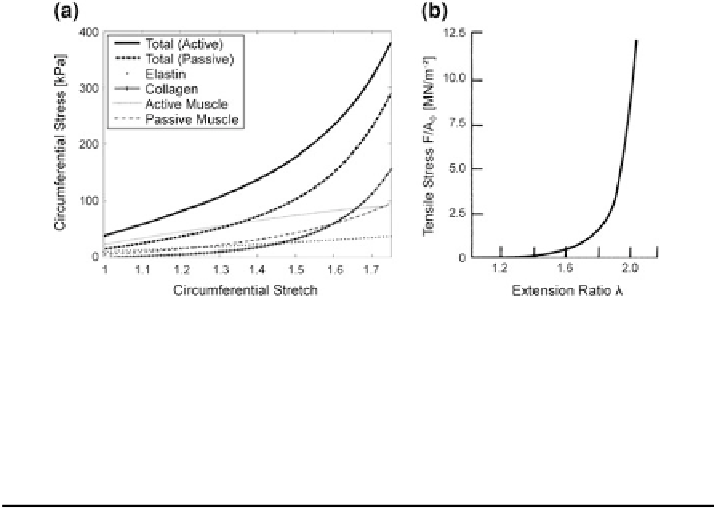Biomedical Engineering Reference
In-Depth Information
Fig. 5.10 a stress-strain behaviour of collagen, elastin, passive and active muscle (Gleason et al.
2004), and b skin from ex vivo tensile testing (Wainwright et al. 1982)
Table 5.1
Approximate mechanical properties of elastin and collagen fibers
Fibres
Modulus of elasticity (MPa)
Tensile strength (MPa)
Ultimate elongation (%)
Elastin
0.6
1
100
Collagen
1,000
50-100
10
Furthermore, all human tissues principally exhibit more or less viscoelastic
(stress) relaxation and/or creep behaviour. The load-displacement diagram thus
shows hysteresis, as can be seen in the example of gluteal skin-fat-muscle
compound (Fig.
5.15
d) (also cf. outlines in
Sect. 3.2.2.2
)
. Table
5.1
lists some
important material parameters of collagen and elastin, (Park 1984), (Fung 1993)
and (Abrahams 1967).
5.2 Human Soft Tissue Compound in the Buttock Region
5.2.1 Introduction
The mechanical loading of soft tissue compounds (skin-fat-muscle), including the
gluteus maximus muscle, is of primary interest (cf. Fig.
5.11
) for numerical
simulation of mechanical interaction between the human body in the seated or
recumbent position and elastic/viscoelastic body support devices. Based on
appropriate in vivo experiments, the mechanical characterization of these tissues is
necessary. The challenge is to separately characterize each tissue component,
primarily skin/fat and muscle to establish individual material parameter sets.
The human sacral region is highly prone to pressure sores, more than 50 %
forming at the sacrum and ischium (Yeoman and Hardy 1954) (Dansereau and
Conway 1964). This region has been subject to several computational studies


